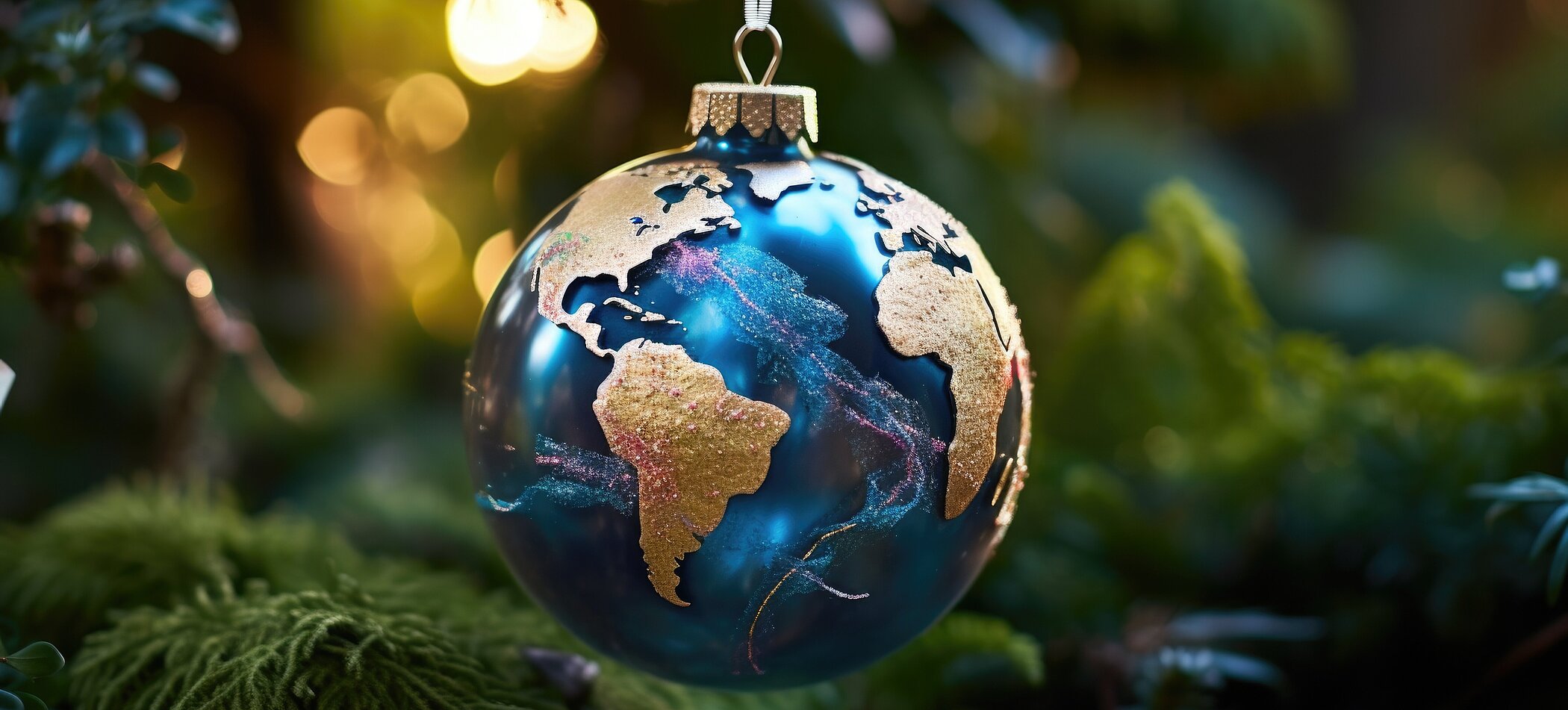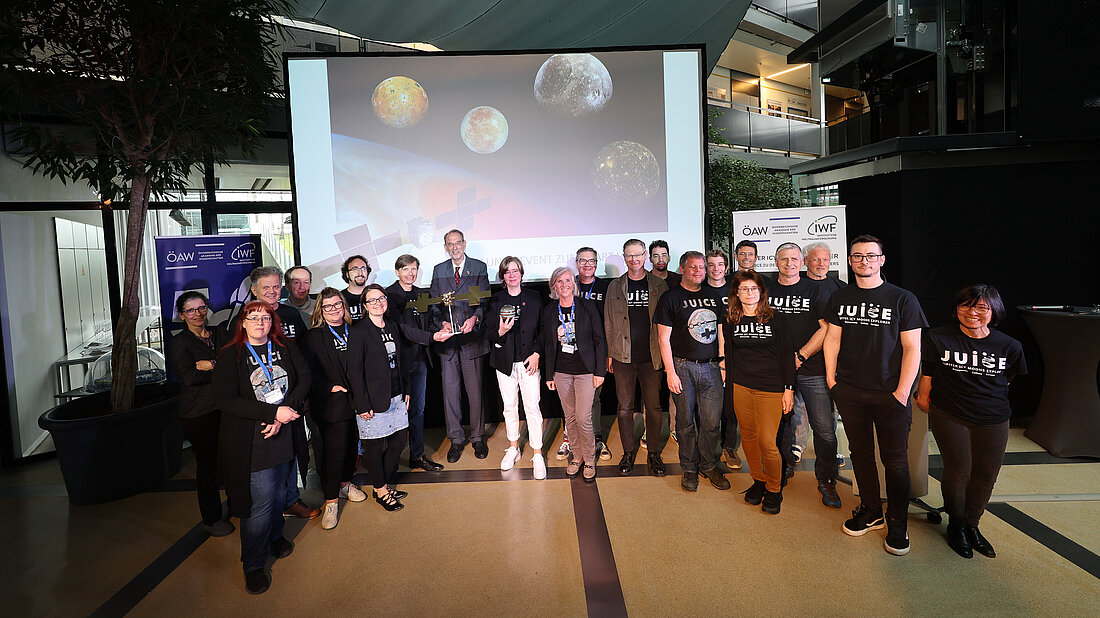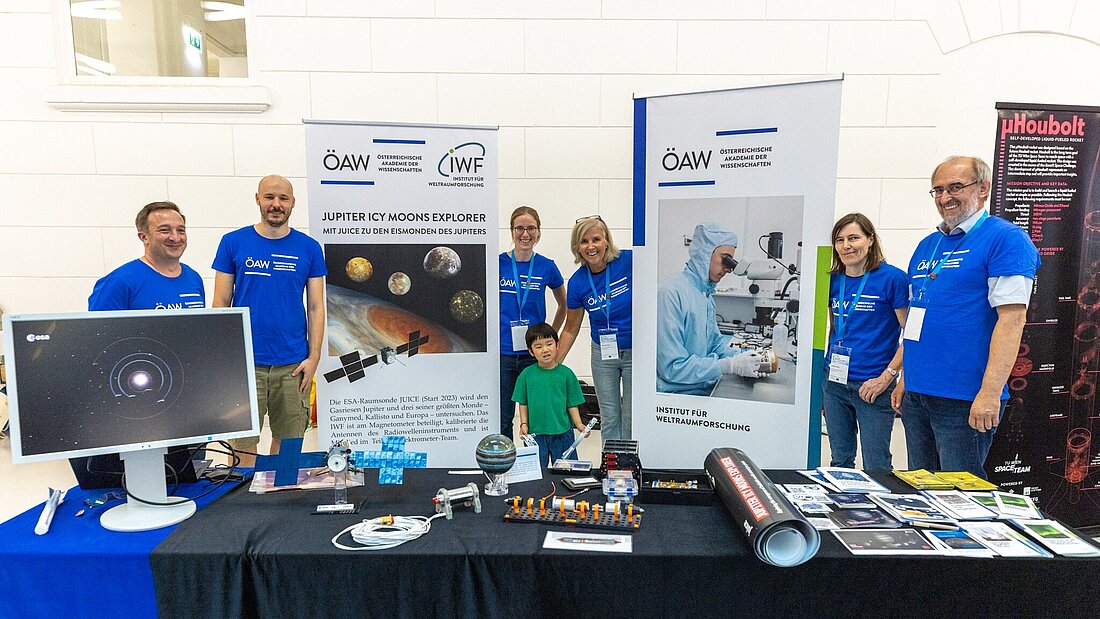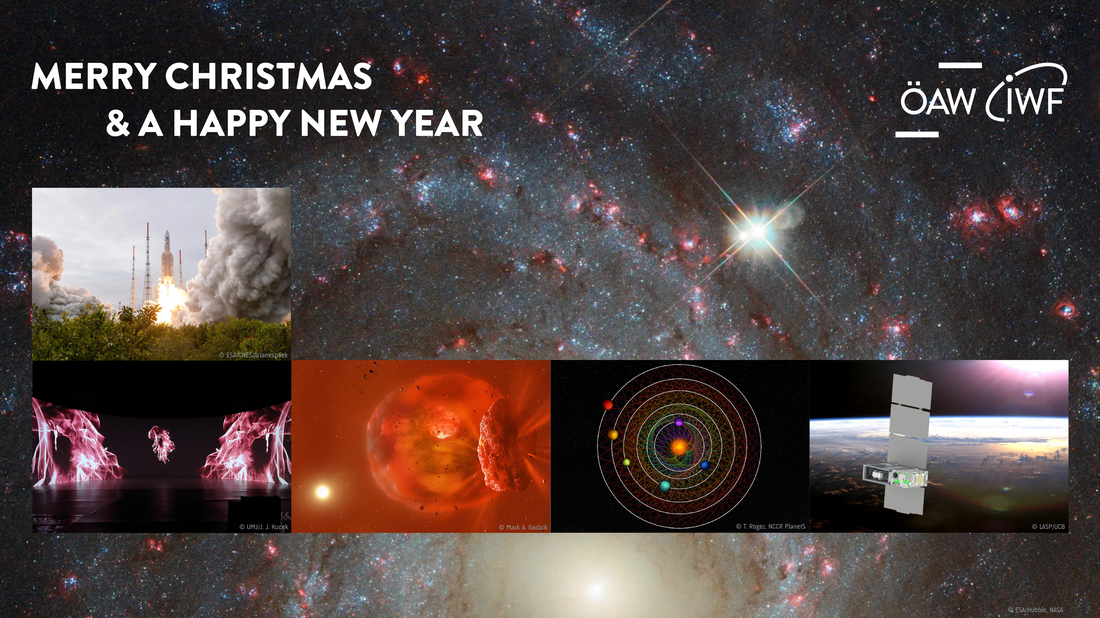
Looking back to 2023
The IWF is on its way to the Jupiter system with JUICE
The clear highlight of the year was the launch of ESA's JUICE mission. Together with the Austrian Research Promotion Agency (FFG), Graz University of Technology, Beyond Gravity, Terma and Geosphere Austria, the IWF organised a launch event, which was attended by numerous guests curious to learn more about Austria's contributions to the JUpiter ICy moons Explorer. Although the launch itself had to be postponed by one day, the spacecraft is now on the right course and the Graz magnetometer is ready to fulfill it's mission.
The IWF as part of SHOWING STYRIA
The scientific questions and results of IWF’s exoplanet researchers inspired artists to video and sound installations shown in the mobile pavilion as part of SHOWING STYRIA under the title “Atmospheres. Art, Climate and Space Research”. The pavilion opened in Vienna in March, then moved to Herberstein and will remain in New York until early 2024. In March, the pavilion was opened in Vienna, it then travelled to Herberstein and is now shown in New York.
The IWF flew by Mercury aboard BepiColombo
In June, BepiColombo performed its third gravity assist maneuver at Mercury, collecting more data from the planetary environment.
The IWF welcomed ESA's Director of Science
Carole Mundell 's first visit to Austria took her to Graz in September, where she presented the activities and plans of ESA's science programme the Austrian space community.
The IWF remains in the running for ESA's next M mission
ESA has narrowed down the shortlist for its next ‘medium’ mission to three finalists. The IWF participates in M-MATISSE and Plasma Observatory and hopes that one of them will be selected for implementation as the newest addition to ESA’s space science mission fleet.
The IWF researches and publishes
Almost 180 scientific articles were published in 2023, 44 first-authored by the IWF. In NatureLudmila Carone and first author M. Kenworthy et al. described a planetary collision and Luca Fossati and first author R. Luque et al. unlocked a rare six-planet system. In Nature GeosciencePatrick Barth et al. provided new insight into the importance of lightning for life on early Earth. In The Astrophysical Journal LettersA.G. Sreejith et al. published the first scientific results of NASA's cubesat CUTE.

The IWF is honoured
Patrick Barth und Jan Philip Sindel successfully defended their PhD theses at the University of St Andrews on "Tracing the chemistry of high-energy processes in planetary atmospheres" and at the KU Leuven on "Cloud formation in exoplanet atmospheres – Nucleation of small molecular clusters", respectively.
IWF Director Christiane Helling was nominated for Austria 23 in the category "research" by the daily newspaper "Die Presse".
Daria Kubyshkina was awarded a Schrödinger Fellowship, which will take her to the University of Bern next year. Yasuhito Narita was appointed Professor of Theoretical Physics at Technische Universität Braunschweig und Owen Wyn Roberts was appointed Lecturer in Physicsat Aberystwyth University.
The IWF goes public
At the kick-off meeting for the Young Researchers Programme for Interdisciplinary Space and Planetary Sciences (YRP@Graz) both the new PhD students and their supervisors had the opportunity to present themselves and their own research. At the CHAMELEON School III, the Early Stage Researchers presented their scientific results to date.
The Alpbach Summer School, entitled "Exoplanets: Understanding alien worlds in diverse environments", focussed on extrasolar planets.
From 7 to 8 September, space enthusiasts learned about current activities and research in the fields of astronomy, astrophysics and space research at the 10th edition of Graz in Space.
During the European Researchers' Night held at the University of Applied Arts in Vienna, the IWF presented its contributions to the JUICE mission to a large number of visitors of all ages.
On 25 and 26 October the IWF presented the project SWAP: The Austrian Platform for Space Weather during an exhibition organised by the Austrian Armed Forces (photos coming soon).
As part of Science Garden, the IWF presented itself at the Faszination Technik Challenge at the Styrian Chamber of Commerce in May and at the 2. MINT-Forum Steiermark at the Kunsthaus Weiz in November.
The autumn/winter astronomy talks at Urania were all about the James Webb Space Telescope (JWST) and research at the IWF.
International guest speakers and local lecturers informed about current research topics and scientific results in the IWF colloquium and seminar series. Some lectures can be watched and listened on the IWF YouTube channel.

The IWF in the media
The IWF received many media enquiries. JUICE was mentioned 145 times in the Austrian press. A small selection of these and other reports is summarised in our media review.
Helmut Lammer contributed to space blog in the newspaper DER STANDARD with an article about Austria's role in the European JUICE mission.
In the new ORF Astro Podcast, (Paul) Agamemnon (Sihorsch) travelled through space with Ruth-Sophie Taubner.
Numerous social media news were spread via X and LinkedIn. The OeAW reported on Facebook on the activities of its institutes, most recently also on those of IWF.
Preview to 2024
24 active and future space missions
The IWF is currently involved in 14 active and 10 future space missions, 9 of which will be launched within the next five years.
On its long journey to the Jupiter system, JUICE will be the first spacecraft to perform a Lunar-Earth gravity assist manoeuvre in August.
BepiColombo will fly by Mercury for the fourth and fifth time on 5 September and 2 December (a total of 1 x Earth, 2 x Venus, 6 x Mercury; it will enter its final orbit in December 2025).
The launch of the Chinese satellite CSES-2 is planned for December, carrying the fourth quantum interference magnetometer into space after CSES-1, JUICE and Macau Science Satellite 1.
The IWF exoplanet researchers are expecting new results on gas giants such as WASP-69b thanks to observations with the James Webb space telescope.
Cluster 's end is near. Launched in 2000, the four satellites helped to understand the interaction between the solar wind and the Earth's magnetosphere. The successful mission has exceeded its nominal lifetime by more than 20 years and reaped a rich scientific harvest - including 133 IWF first-author publications. From September, the satellite quartet - also known as Rumba, Salsa, Samba and Tango - will stop dancing and burn up in the Earth's atmosphere.

Some dates to mark in your calendar
The IWF event calendar already offers a small foretaste of the upcoming colloquia and seminars as well as the next Long Night of Research, which will once again attract numerous guests to Schmiedlstraße and the Lustbühel Observatory on 24 May.
With the OeAW young science initiative "Akademie im Klassenzimmer", schools can book IWF researchers to give a lecture in the classroom. The new programme will be available online soon.
The next YRP call is planned for spring.
The exhibition "Atmospheres. Art, Climate and Space Research" will travel from New York to the Massachussetts Institute of Technology and will then be shown in Slovenia.
The Alpbach Summer School will be dedicated to the icy moons of the outer solar system.
The next European Astrobiology Network Association event (EANA2024) will take place from 3 to 6 September in Graz.
If you would like to be regularly informed about IWF's news and events, please subscribe to our mailing lists.
Merry Christmas
With this brief overview, the IWF wishes a Merry Christmas and a healthy and successful New Year with lots of exciting space adventures to come.
